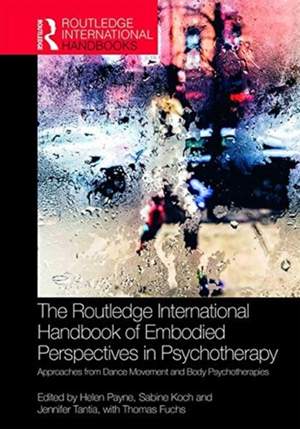The Routledge International Handbook of Embodied Perspectives in Psychotherapy: Approaches from Dance Movement and Body Psychotherapies
- Editor: Payne, Helen
- Editor: Tantia, Jennifer
Book
$287.25Printed on demand
Contents
- List of Figures
- List of Tables
- List of Contributors
- Foreword by Don Hanlon Johnson
- Foreword by Vassiliki Karkou
- Foreword by Babette Rothchild
- Preface
- Acknowledgements
- List of Abbreviations
- Introduction to Embodied Perspectives in Psychotherapy: Helen Payne, UK; Sabine Koch, Germany; Jennifer Tantia, USA; and Thomas Fuchs, Germany
- Section One: Overview of Concepts
- Introduction to Section
- Essential Dimensions of Being a Body - Maxine Sheets-Johnstone, USA
- Narrratives in Embodied Therapeutic Practice: Getting the story straight - Shaun Gallagher, USA and Daniel D. Hutto, Australia
- Towards a Clinical Theory of Embodiment: A model for the conceptualization and treatment of mental illness - Jessica Acolin, USA
- The Evidence for Basic Assumptions of Dance Movement Therapy and Body Psychotherapy Related to Findings from Embodiment Research - Johannes Michalak, Naomi Lyons, and Thomas Heidenreich, Germany
- Having a Body and Moving your Body: Distinguishing somatic psychotherapy from dance/movement therapy - Jennifer Tantia, USA
- Section Two: Theory and Practice in Dance Movement Psychotherapy
- Introduction to Section
- A Developmental Taxonomy of Interaction Modalities in Dance Movement Therapy - Marianne Eberhard-Kaechele, Germany
- Witnessing Practice: In the eyes of the beholder - Tina Stromsted, USA
- Somatic Body Mapping with Women During Life Transitions - Annette Schwalbe, UK and Kenya
- Gravity in the Development of the (Body) Self in Dance Movement Psychotherapy - Diana Cheney, UK
- Dance Movement Therapy: Building resilience from shared movement experiences - Rosemarie Samaritter, The Netherlands
- Interrupted Rhythms: Dance/movement therapy's contributions to suicide prevention - Susan D. Imus, USA
- Body as Voice: Restorative dance/movement psychotherapy with survivors of relational trauma - Amber Gray, USA
- Playing Through Dancing Stories - Sylvie Garnero, France
- Psychological Re-sources in Integral Dance and Dance/Movement Therapy - Alexander Girshon and Ekaterina Karatygina, Russia
- Mother-Son Transgenerational Transmission of Eating Issues in a Co-treatment Method using the Ways of Seeing Approach - Suzi Tortora and Jennifer Whitley, USA
- The BodyMind Approach and People Affected by Medically Unexplained Symptoms /Somatic Symptom Disorder - Helen Payne, UK
- The Disturbance of the Psychosomatic Balance - Haguit Ehrenfreund, Switzerland
- Modulating Verbal and Non-Verbal Languages in Dance Movement Psychotherapy: Moving conversations with adult patients in private practice -Teresa Bas, Spain; Diana Fischman, Argentina; and Rosa M Rodriguez, Spain
- The Importance of Subtle Movement and Stillness in Japanese Dance Movement Therapy: A comparison with the Japanese traditional performing art of 'Noh' - Miyuki Kaji, Japan
- Embodiment of Space in Relation to the Self and Others in Psychotherapy: Boundlessness, emptiness, fullness, and betweenness - Rainbow Ho, Hong Kong
- From the Alps to the Pyramids: Swiss and Egyptian perspectives on dance movement therapy -Iris Brauninger, Switzerland and Radwa Said Abdelazim Elfeqi, Egypt
- Section Three: Theory and Practice in Body Psychotherapy
- Introduction to Section
- Relating Through the Body: Self, other and the wider world - Gill Westland, UK
- Functional Relaxation in Psychosomatic Medicine - Ursula Bartholomew and Ingrid Herholz, Germany
- The Art of Bottom-Up Processing: Mindfulness, meaning and self-compassion in body psychotherapy - Halko Weiss and Maci Daye, Germany
- Embodied-Relational Therapy - Nick Totton, UK
- Four Forms of Knowledge in Biosynthesis Therapy - David Boadella, Switzerland
- The Relational Turn in Body Psychotherapy - Michael Soth, UK
- Emotional Regulation in Body Psychotherapy - Ulfried Geuter, Germany
- The Embodiment of Dreams: Exploring mind/body connecting devices - Michel Coster Heller and Gillat Burckhardt-Bartov, France
- The Therapist's Body and the Intersubjectivities of the Unconscious -Tom Warnecke, UK
- Being Moved to Tears: Somatic and motoric aspects of self-disclosure - Asaf Rolef Ben-Shahar, Israel
- Oppression and Embodiment in Psychotherapy - Rae Johnson, USA
- Micromovements: Filling out the movement continuum in clinical practice - Christine Caldwell, USA
- Safety in Psychotherapy: The body matters - Helma Mair, Ireland
- Touch and Embodiment: Body-oriented psychotherapeutic applications of clinical touch - Michael Changaris, USA
- Traumatic Dis-embodiment: Effects of trauma on body perception and body image - Maurizio Stupiggia, Italy
- Research Informing Body Psychotherapy Clinical Work: A spotlight on emotions - Margit Koemeda-Lutz, Switzerland
- Appendix
- Index



